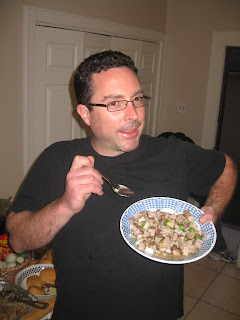Food and Oral History: Chicken Adobo
 |
| Photo from Life's Ambrosia |
Luckily, living in a city with an international pallate makes the quest easy to trace recipes that are at risk of being lost. If you think I am wrong, ask yourself how many Filipino restaurants there are in Houston and if they truly make the favorites the same way. Ask yourself why these restaurants or the dishes at these restaurants have not made it into the mainstream like Italian or Greek or Chinese dishes. The answers to these questions can be explored to no end. It comes down to the fact that again, nobody makes it as good as momma. That reality is the perfect motoviation for anyone to go on a search for lost dishes of any culture or family. Me? I still do not know how to cook them. What I want to avoid, is my children asking these same questions when I am gone and they can not duplicate or remember that dish from way back when.
I think it is appropriate I begin this adventure with Chicken Adobo.
Next to pancit, Chicken Adobo is one of the most nostaligic of all the Filipino dishes. This was relevant in a highly attended "H-Town Adobo Hoedown" held in Houston a couple of years ago.
Of course nobody makes Chicken Adobo as good as their own mother.
So here goes - my mother's version of Chicken Adobo.
I am not sure why this recipe was so painful to extract from my mother. We went down these tangents and stories while trying to document this recipe. The whole family sat around the living room, contributing to the conversation. My brother and father critiqued the cooking approach as we pondered interpretations. The irony is that this recipe is made up of very simple ingredients. In my lifetime, I have yet to hear a consistent way this dish has ever been cooked by my mother. Perhaps that is the secret ingredient that she uses to protect the family recipe. This dish could never be patented because one is never really supposed to make this the same way every time.
My mother used this stirring spoon for measuring and could not really tell me the measurements initially. We actually had to go into the kitchen and measure how many tablespoons the stirring spoon equaled.
Chicken Adobe
A whole large chicken cut up in pieces.
1/2 tsp salt
4 cloves of garlic, minced, chopped
1/2 a medium onion
4 tbls. (about 1 overflowing stirring spoon) soy sauce
4 cracks of the pepper mill
1 tbls. of sugar
6-7 tbls. (about 2 stirring spoons) of vinegar (use 7 tbls. if you want a more sour taste) and (if pork use more vinegar)
1/2 c. water (use more water if you want more broth, but not too much more, you might water down the flavor.)
2 bay leaves
Cut the chicken in pieces
Remove the yellow fat and the joints and some of the skin, but not all of skin.
Also, remove the slimy layers under the thigh and legs.
Mix the salt, garlic, onion, soy sauce, pepper, sugar, and vinegar, and bay leaves with the chicken in a large pot.
Simmer until tender.
Some simmer until all the liquid has evaporated. Mom leaves a little liquid.
Some simmer and leave a liquid in the bottom of the pot so they can pour some of the broth over their rice.
Some cook the chicken completely and then add the vinegar last.
If in a hurry, some will par cook the chicken then remove the liquid, then brown the chicken and re add the liquid.
If you do not want to bother with cleaning the chicken, boneless, skinless, chicken thighs from Costco works as well.
As children, we fought over what little liquid was left in the bottom of the pot. So for best results, to avoid family conflict - reserve the liquid. This makes for a more peaceful dinner experience, especially if you have a typically large Filipino family like mine. The broth, made the long way, that is the love part in this dish - I truly believe.
The final twist to this recipe? My husband is the one who cooks this dish for me in the house and he is not even Filipino, he just knows the way to my heart.
References:
Photo from Life's Ambrosia - permission pending
http://www.lifesambrosia.com/2008/11/chicken-adobo.html
References:
Photo from Life's Ambrosia - permission pending
http://www.lifesambrosia.com/2008/11/chicken-adobo.html



Well done! Thanks for sharing. Now I am hungry....
ReplyDelete